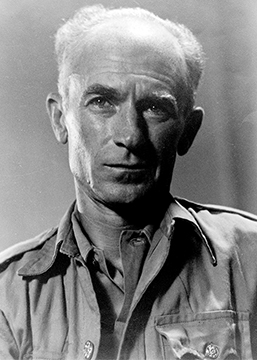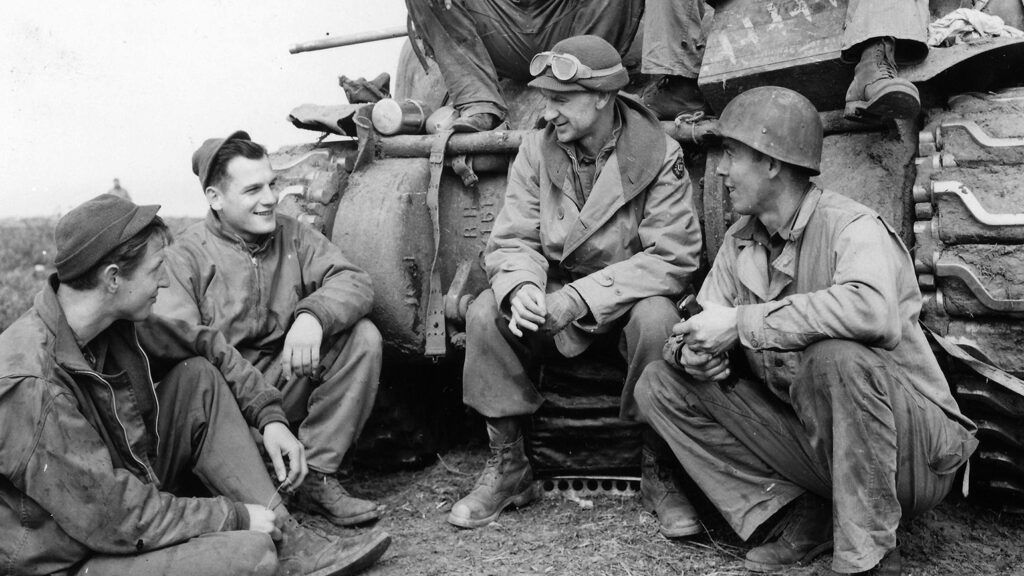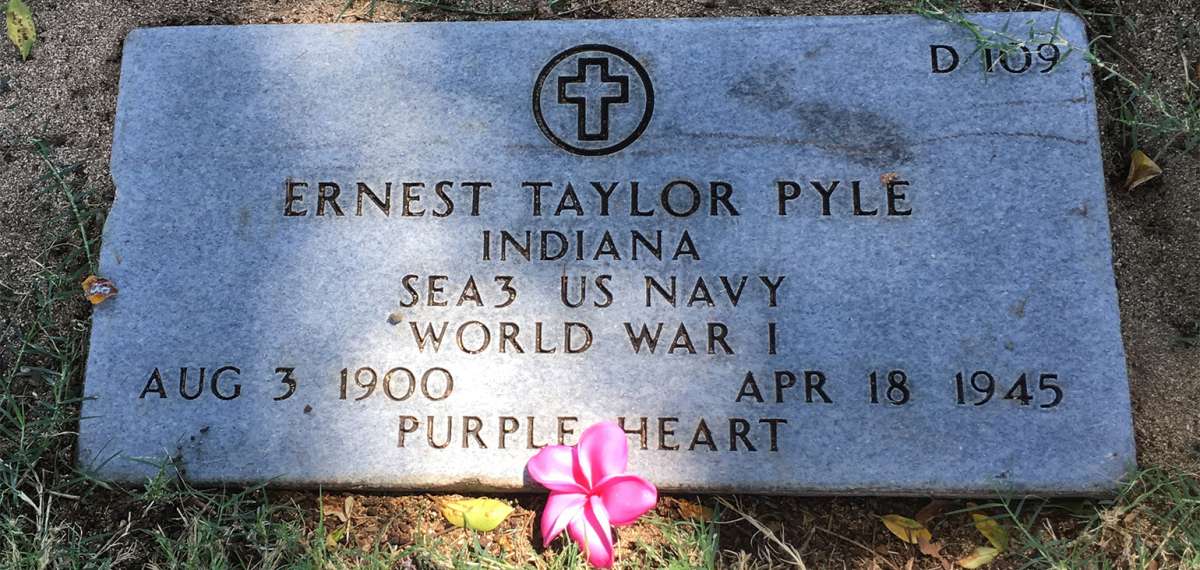Heroes come in all shapes and sizes, though a diminutive newspaper reporter from the Midwest might seem an unlikely candidate for that status. But Pulitzer Prize–winning journalist Ernest Taylor “Ernie” Pyle was indeed a hero to millions of Americans who appreciated his bravery in reporting the experiences of the common soldier, sailor and airman during World War II.

Pyle attended Indiana University where he served as the editor of the student newspaper, The Indiana Daily. With just one semester remaining before graduation, however, he quit school to accept a position at a newspaper in LaPorte, Indiana.
After three months on the job, Pyle relocated to Washington, D.C., where he worked for The Washington Daily News, a tabloid daily with an unusually young editorial staff. He was hired as a reporter, but in 1922, he was named managing editor. He held that job for three years, growing increasingly frustrated that he wasn’t doing any writing, so in 1926, Pyle resigned so that he and his new bride, Jerry, whom he wed in 1925, could travel.
Over the next two years, the Pyles traveled the United States in a Ford roadster before returning to D.C., where Pyle became the country’s most prominent aviation columnist. No less an authority than Amelia Earhart once said, “Any aviator who didn’t know Pyle was a nobody.”
By 1932, Pyle was again served as managing editor of The Washington Daily News, but after a sojourn in California, meant to allow him time to recover after a severe case of the flu, Pyle was asked to fill in for the prominent columnist Heywood Hale Broun, who was on vacation. He wrote 11 essays about his stay in California and the residents of that state whom he’d encountered during his stay.
The columns were very well received, and not just with readers. G. B. Parker, the editor-in-chief of the Scripps-Howard newspaper chain, wrote that Pyle’s work had “a Mark Twain quality that knocked my eye out.” Parker made Pyle an offer, which was quickly accepted, to undertake a daily column for Scripps-Howard that would send Pyle motoring along the back roads and byways of the United States, as he and Jerry had done some years before, and writing a daily column about his experiences—the places he saw, the people he met.
With Jerry frequently at his side—”that girl who rides with me,” as he referred to her in his column, Pyle traveled over 200,000 miles, crossing the United State some 30 times “by practically all forms of locomotion, including piggyback.”
“We have stayed in more than eight hundred hotels,” Pyle wrote, “flown in sixty-six different airplanes, ridden on twenty different boats, walked two hundred miles, gone through five sets of tires and put out approximately $2,500 in tips.” And Pyle and Jerry didn’t limit their travels to the U.S.; they traveled to every country (save two) in the Western Hemisphere. Any and every experience along the way was potential material for his column, and Pyle’s readers were grateful for the chance to vicariously share in his adventures.
SHOW YOUR SUPPORT: MAKE A CONTRIBUTION TO GUIDEPOSTS MILITARY OUTREACH
Pyle’s accessible, intimate prose appealed to average Americans, and the travel column proved to be very popular, indeed. It continued from 1935 until the United States entered World War II. By then, Pyle felt the call of a greater purpose.
In 1940, Pyle reported on the Battle of Britain from London, and his first-person account of the bombing onslaught England was undergoing and the impact it had on the lives of average Brits gave Americans insight into the war in Europe that other war reporting couldn’t achieve.
The “little fellow,” as Pyle often referred to himself (“I weigh 108 pounds, eat left-handed, am 28 inches around the waist, and still have a little hair left,” he once wrote) was uniquely positioned to give Americans and people around the world a glimpse of what those living through the war—both the soldiers fighting it and the civilians who had their lives disrupted by it—were experiencing, and after the United States entered the war on December 8, 1941, those on the home front relied on Pyle for insights and information about what their sons and daughters serving overseas were experiencing.
Pyle was arguably the first embedded reporter, a recent term that describes as well as any other his approach to war reportage. Pyle’s was not a macro approach, but a micro one. His intention was not to relate the success and failings of military campaigns or to profile generals, admirals and others among the top brass. He spent his time with the common soldiers and related what they were going through. His reports appeared in more than 300 newspapers, so his audience was vast and his readers avidly scoured every report he filed so that they might have a greater sense of what their sons and daughters were experiencing.
In 2004, Bill Damico, a retired Marine, told the military newspaper Stars and Stripes, “Ernie Pyle was a man who was down with the troops, down in the trenches with the guys. He wrote simply, for the common man, so you could understand him and what the troops were going through.”
When Pyle’s columns were collected in book form, in four volumes entitled Ernie Pyle In England, Here Is Your War, Brave Men and Last Chapter, they were instant bestsellers. The rights to Pyle’s war reports were even purchased by Hollywood and adapted for the 1945 motion picture The Story of G.I. Joe, directed by William Wellman and starring Burgess Meredith and Robert Mitchum.
When American troops first began to arrive in Europe, Pyle was there. He later accompanied the troops during the North Africa campaign and during the invasions of Sicily and Italy. He arrived at Normandy on June 7, 1944, the day after D-Day, reporting on the tremendous sacrifices the Allied troops had made there.
In July, Pyle was nearly killed during an accidental bombing by the Army Air Forces during Operation Cobra near Saint-Lô in Normandy. In August, he was on hand to witness firsthand the liberation of Paris.
That same year, Pyle wrote a column calling for combat pay for members of the infantry, much as airmen were paid “flight pay.” Before long, Congress approved an increase in pay of $10 a month for combat infantrymen. The law was entitled “The Ernie Pyle Bill.” Pyle was awarded the Pulitzer Prize for Correspondence that year, for “distinguished war correspondence during the year 1943.”
With the tide having turned in Europe, Pyle turned his sights to the Pacific. In preparing to change his base of operations, he had a run-in with the Navy, which forbade the use of sailors’ names by reporters, a policy which very much ran counter to Pyle’s approach to reporting. After butting heads with Navy brass for a while, Pyle claimed a partial victory: The ban was lifted, but for him only.
|
Celebrating Ernie Pyle Day Jerry Maschino, a board member with the Ernie Pyle Legacy Foundation, told the Albuquerque Journal in 2016, “A lot of people, if you ask them, ‘Do you know Ernie Pyle?’ will answer yes, but if you ask about specifics, they usually don’t know any, other than he was a war correspondent. But there’s a lot more to Ernie Pyle than that. “Our mission is simple: Ensure the legacy of Ernie Pyle.” |
Pyle had mixed feelings about going to the Pacific. He was understandably fatigued, both physically and emotionally, after covering the war in Europe for several years, and his ongoing battle with clinical depression was taking a toll on him. He was even experiencing premonitions of death.
“I feel that I’ve used up all my chances, and I hate it,” Pyle said. “I don’t want to be killed.” But he pushed forward across the Pacific because, as he put it, “there’s a war on and I’m part of it…. I’ve got to go, and I hate it.”
Pyle was with the Marines when they landed at Okinawa, and on April 18, 1945, while with the Army’s 305th Infantry Regiment of the 77th “Liberty Patch” Division on the island of Iejima, he was riding in a Jeep toward the front lines when he was struck in the left temple by a Japanese machine-gun bullet. He died instantly.
It speaks to the deep respect and gratitude those in the United States military felt toward Pyle that his tragic death was announced the next day by Secretary of the Navy James V. Forrestal. Pyle was buried with his helmet on alongside other battle casualties. The men of the 305th erected a monument at the site of his death. That monument still stands; its inscription reads, “At this spot the 77th Infantry Division lost a buddy. Ernie Pyle, 18 April 1945.” The site, owned by American Legion Post 28, is today maintained by the U.S. Marines assigned to the island.
Pyle was mourned by millions of Americans, who felt they had lost a close friend, someone who had, in his unique way, paid tribute to the sacrifices of their sons and daughters as they served their country in the most difficult and dangerous of times.
Harry Truman, sworn in as President of the United States just six days prior to Pyle’s passing, said of him, “No man in this war has so well told the story of the American fighting man as American fighting men wanted it told. He deserves the gratitude of all his countrymen.”
Eleanor Roosevelt, who often quoted Pyle’s dispatches in her own newspaper column, wrote of Pyle on the day after his death, “I shall never forget how much I enjoyed meeting him here in the White House last year, and how much I admired this frail and modest man who could endure hardships because he loved his job and our men.”
But it was author John Steinbeck who may perhaps have explained better than anyone what made Pyle special when he told a reporter for Time magazine, “There are really two wars and they haven’t much to do with each other. There is the war of maps and logistics, of campaigns, of ballistics, armies, divisions and regiments—and that is General [George] Marshall’s war.
“Then there is the war of the homesick, weary, funny, violent, common men who wash their socks in their helmets, complain about the food, whistle at the Arab girls, or any girls for that matter, and bring themselves through as dirty a business as the world has ever seen and do it with humor and dignity and courage—and that is Ernie Pyle’s war.”
On July 19, 1949, Ernie Pyle was reinterred at the National Memorial Cemetery of the Pacific in Honolulu, with a crowd of 2,000 mourners in attendance, and there he rests today, alongside 31,000 other American casualties of the Second World War. In 1983, Pyle was awarded the Purple Heart, a rare honor for civilians. Though he did not serve as a soldier in World War II, that Purple Heart affirms Pyle’s status as a genuine hero, one who served his fellow Americans, both military and civilian, with distinction, courage and compassion and made the ultimate sacrifice in doing so.







